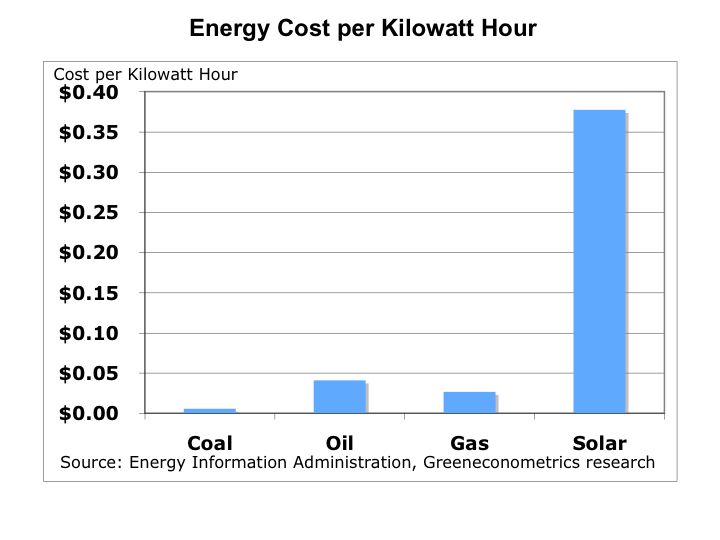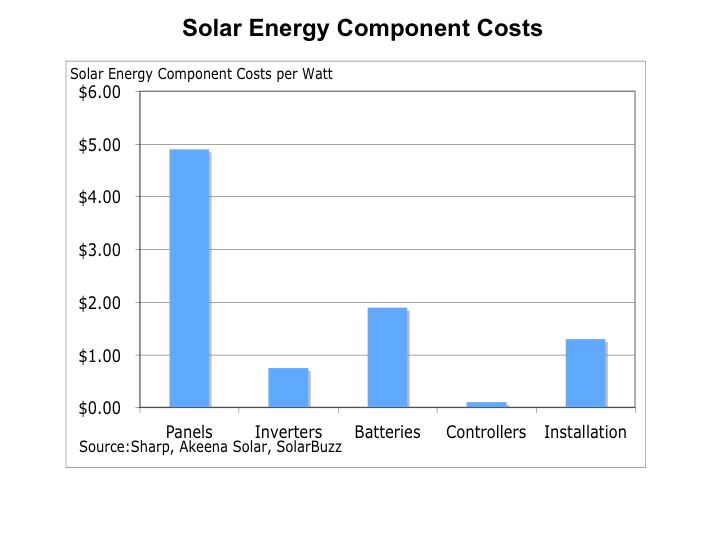Understanding the Cost of Solar Energy
In comparison to conventional hydrocarbon fuels such as coal or oil in generating electricity, the cost of solar energy is significantly higher. To compare energy cost, a common equivalent is required. Back in our previous post, Coal: Fueling the American Industrial Revolution to Today’s Electric, we developed a framework to measure energy costs by converting costs to kilowatt-hours (KWH).
In our example, a ton of coal on the average produces approximately 6,182 KWH of electric at a cost of about $36 per short ton (2,000 pounds). Under this measure coal cost less than$0.01 per KWH. In comparison, a barrel of oil at $70/barrel produces 1,700 KWH at a cost approximately $0.05 per KWH. Let’s provide some measures to understand energy costs.
Energy Units and Conversions KEEP
Energy Comparison
1 ton of coal = 6,182 KWH
1 barrel of oil = 1,699 KWH
1 cubic foot of gas = 0.3 KWH
Energy Costs
1 ton of coal costs $36 = $0.006 per KWH
1 barrel of oil costs $70 = $0.05 per KWH
1 cubic foot of gas $0.008 = $0.03 per KWH
In comparison to solar energy, the hydrocarbon fuel costs are significantly lower without rebates, tax benefits nor the cost of carbon emissions. A two–Kilowatt (KW) solar energy system costs about $45,000 and covers roughly half of a typical American household’s energy needs. At $45,000, a solar energy system equates to $9,000 a kilowatt. The $9,000 per KW for solar is not very helpful in comparing electric generation costs to other fuels like coal or gas. Since coal, oil, and gas can be measured on a cost per KWH, we should measure solar costs on a KWH basis.
Some of the considerations for a solar energy system include the 20-to-30 year lifespan of the system and the hours of available sunlight. The hours of available sunlight depends on latitude, climate, unblocked exposure to the sun, ability to tilt panels towards the sun, seasonality, and temperature. On the average, approximately 3.6 peak sunlight hours per day serves as a reasonable proxy to calculate the average annual output of electric from solar energy panels.
Solar Energy Costs
Average system costs = $95 per square foot
Average solar panel output = 10.6 watts per square foot
Average solar energy system costs = $8.95 per watt
In order to compare the solar energy costs to conventional hydrocarbon fuels, we must covert the $8.95 per into KWH. Let’s make two calculations to measure the total electric energy output over the lifespan of the solar energy system. The first adjustment is to convert solar direct-current (DC) power to alternating current (AC) power that can be used for household appliances. The conversion of DC to AC power results in an energy loss of 10 percent for a solar energy system. The second calculation is to approximate total electric output by multiplying the average peak hours of sunlight (about 3.63 hours per day) times 365 days times 20 years (the product lifespan).
For our 5-KW solar energy system costing $45,000, the conversion to KWH is as follows:
5 KW times 90% = 4.5 KW – (Conversion of DC to AC power)
4.5 KW times 3.63 hours = 16 KWH per Day
16 KWH x 365 = 5,962 KWH – (Average Annual Output)
5,962 KWH x 20 years = 119,246 KWH – (Total output over 20 year lifespan)
So a $45,000 5KW solar energy system produces about 119,246 KWH of electric over its lifespan meaning the average cost equals $0.38 per KWH. ($45,000 divided by 119,246 KWH)
Figure 1 Cost of Energy

The relatively high solar energy costs in comparison to conventional fuels should improve with utility rebates and government tax incentives. In addition, solar panel prices should continue to decline as volume production increases. Solar cell manufacturers employ similar production methods as semiconductor suppliers and benefit from economies of scale.
There are several components of a solar energy system. Solarbuzz provides some detailed information on solar industry pricing. Solarbuzz
The single largest cost is the solar panels themselves. The following figure provides an overview of the components of a solar energy system. Sharp Solar provides a very useful calculator for system costs and electric generation by geographical location along with utility rebates for your area. Sharp Solar Energy
Figure 2 Solar Energy Component Costs

We will explore the some of the advances in thin-film technologies, the declining costs of solar panels, and the improving solar conversion efficiencies that should continue to bring solar energy costs on par with hydrocarbon fuels. With the improving cost structure of solar and a better understanding of the cost of carbon emissions from hydrocarbon fuels, we may find a more level playing field in comparing energy costs.
Tom
I like your graphs on expensiveness of solar energy. Although you don’t really go on to say how good of an investment solar energy actually is, in the long run.